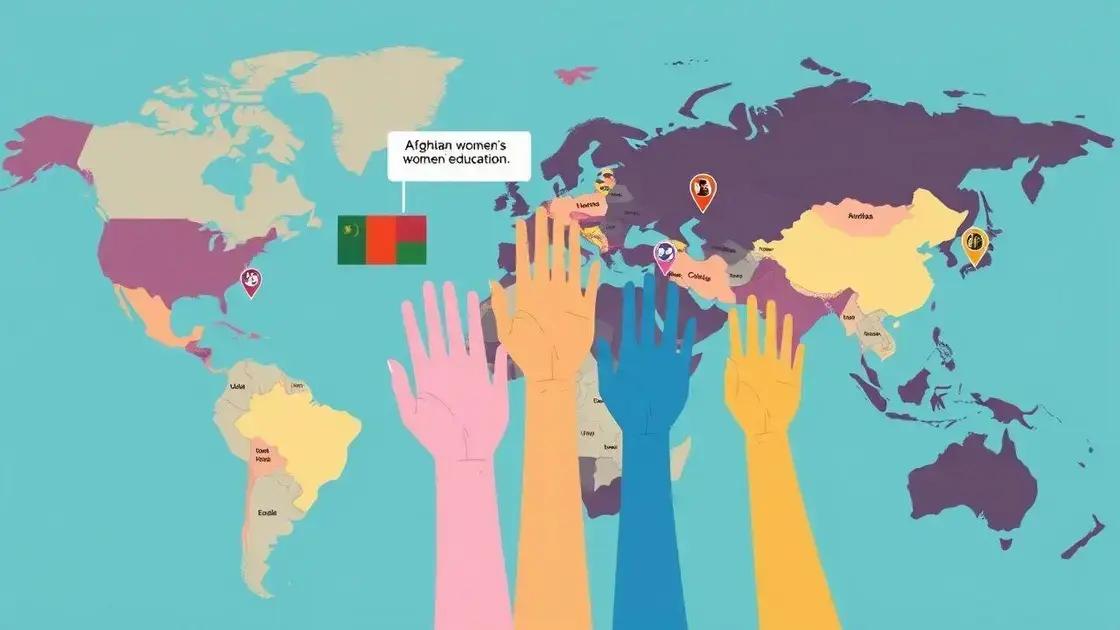Trump cuts educational funding for Afghan women studying abroad

Anúncios
Trump cuts educational funding for Afghan women studying abroad significantly hinder their access to education, creating barriers that affect their future opportunities and the overall development of their communities.
Trump cuts educational funding for Afghan women studying abroad has sparked significant discussions. What does this mean for their education and future? Let’s dive into the implications.
Anúncios
Impact of educational funding cuts
The impact of educational funding cuts on Afghan women studying abroad is profound. These cuts create barriers that can hinder their access to quality education and future opportunities. Without adequate funding, many students may have to abandon their dreams of pursuing higher education.
Immediate consequences
When funding is reduced, the first effect is often a decrease in available scholarships. This situation forces students to seek alternatives, which may not always be feasible. Many talented individuals may end up missing out on critical educational experiences.
Anúncios
Long-term effects
The long-term effects of these funding cuts can be devastating for entire communities. Educated women are crucial for the development of their societies. If they cannot study, the cycle of poverty continues.
- Limited access to educational resources.
- Increased reliance on family support.
- Lower rates of women pursuing STEM fields.
Additionally, as the educational landscape becomes more challenging, the stigma attached to women pursuing education may amplify. This creates a societal barrier that extends beyond financial limitations. Families might prioritize funding for male relatives, perpetuating gender inequality in education.
In the larger scope, these challenges affect not only individual students but also global perspectives on education in conflict regions. The loss of educated Afghan women could lead to fewer voices advocating for change and progress in their communities.
Exploring solutions
Finding ways to counteract these cuts is vital. International organizations and governments must come together to create funding programs specifically tailored for Afghan women. Engaging local communities in supporting educational initiatives can also pave the way for sustainable solutions.
By working collectively, we can help ensure that Afghan women have the necessary support to continue their studies abroad. Their education is not just about personal growth; it impacts the future of their communities and beyond.
Challenges faced by Afghan women students
The challenges faced by Afghan women students are immense, especially in the current climate of uncertainty. These women encounter numerous barriers that can prevent them from achieving their educational goals. From security concerns to financial instability, the road to education is fraught with obstacles.
Security issues
One significant challenge is the risk to their safety. Many women fear for their personal security while trying to attend school. This fear arises from ongoing conflicts and the hostile environment in which they live.
Financial barriers
Financial challenges also play a crucial role in limiting opportunities. Many Afghan families struggle to support their daughters in education, often prioritizing boys. This results in fewer resources for women, making it harder for them to pursue higher education.
- High tuition fees for international institutions.
- Limited scholarship opportunities tailored for women.
- Financial pressures to support family instead of pursuing education.
Additionally, societal expectations can be daunting. In some communities, there is pressure for women to conform to traditional roles, which often don’t include education. This pressure can lead to a decrease in motivation to continue studies.
Moreover, the lack of adequate educational facilities can hinder their progress. Many schools and universities do not provide a safe and supportive environment. This lack can discourage women from pursuing their degrees entirely.
Limited educational resources
With inadequate access to learning materials, women struggle to keep up with their male counterparts. This situation creates a gap that is hard to bridge. Resources such as books, technology, and even internet access are often limited, further impacting their educational journey.
Overcoming these challenges requires strong support from the international community and local leaders. By advocating for policies that prioritize education for women, we can begin to change the narrative and empower Afghan women to pursue their dreams.
International response to the funding cuts

The international response to the funding cuts for Afghan women has been varied and significant. Many countries and organizations are stepping in to address the educational needs of these women, emphasizing the importance of their education for global stability.
Global Advocacy
Several international NGOs have launched campaigns to raise awareness about the challenges that Afghan women face. These organizations are working to gather support and funding to provide scholarships and resources.
Government Contributions
Countries around the world have also begun to respond. Some governments are committing funds to support educational programs specifically designed for Afghan women. This financial aid aims to fill the gap left by cuts from other sources.
- New scholarship programs targeted at Afghan women.
- Collaborations between universities to exchange knowledge and support.
- Increased funding for remote learning platforms for students.
International bodies, such as the United Nations, are taking a stand by calling for policy changes that promote women’s education in Afghanistan. They emphasize that education is a human right and vital for peace and development.
Moreover, public awareness campaigns have gained momentum, aiming to educate citizens about the plight of Afghan women. These campaigns often utilize social media, reaching a wide audience and fostering global solidarity. By highlighting personal stories, advocates are drawing attention to the resilience of Afghan women and their quest for education.
Collaborative Efforts
Partnerships are also being formed between educational institutions. By collaborating, universities can extend outreach efforts, providing Afghan women access to global educational resources. Additionally, these partnerships foster cultural exchange and broaden perspectives for all involved.
As these efforts continue, it becomes clear that the educational landscape for Afghan women can transform. With increased awareness and collaborative funding, there is hope for creating pathways for these women to reach their educational goals.
Future of education initiatives for Afghan women
The future of education initiatives for Afghan women is hopeful, as numerous organizations are paving the way for transformative changes. By investing in educational programs, we can empower women to chase their dreams and set a precedent for future generations.
Innovative educational programs
Many initiatives are focusing on providing flexible learning opportunities. Programs that offer online courses are becoming more popular, allowing women to learn at their own pace. This flexibility helps them balance their education with other responsibilities.
Community-based support
Community involvement plays a crucial role in these initiatives. Local leaders are stepping up to advocate for education, urging families to support their daughters in pursuing higher education. When communities unite, they create a supportive environment that fosters learning.
- Mentorship programs connecting students with successful women.
- Workshops on financial literacy and entrepreneurship.
- Collaborative projects between local schools and international universities.
In addition, there is a growing emphasis on STEM education for Afghan women. By encouraging them to pursue careers in science, technology, engineering, and mathematics, we can help bridge the gender gap in these fields. This shift not only benefits individual women but also strengthens the overall economy.
Furthermore, scholarships and funding opportunities are crucial for sustaining these initiatives. Partnerships between governments and international organizations can provide the necessary financial support to ensure that Afghan women can continue their education abroad.
Langauge and culture programs
Language programs are also becoming essential. Offering courses in English and other languages can help women access wider educational resources. Understanding different languages opens doors to global learning and communication.
Ultimately, the future for Afghan women in education is not just about survival, but about thriving. With the right resources and support, they can become leaders and change-makers in their communities.
Potential solutions to support Afghan women studying abroad
Exploring potential solutions to support Afghan women studying abroad is vital. Many organizations and individuals are working on strategies to empower these women through education. Creating pathways for their success is crucial for their future and for the communities they represent.
Increased scholarship opportunities
One effective solution is establishing more scholarship programs specifically aimed at Afghan women. These scholarships can cover tuition, living expenses, and travel costs, making studying abroad more accessible.
Mentorship and guidance
Mentorship programs can provide Afghan women with essential guidance. Connecting them with female leaders in their fields can inspire confidence and provide practical advice. Mentors can help navigate academic environments and cultural differences.
- Workshops on academic skills and cultural adaptation.
- Resilience training to cope with challenges abroad.
- Networking events to build professional connections.
Additionally, community support is crucial. Engaging families and communities in discussions about the benefits of women’s education can encourage more women to pursue studying abroad. When communities support their daughters’ ambitions, it leads to better outcomes for everyone.
Online education can also serve as a bridge for those unable to travel due to financial constraints or safety concerns. Many universities now offer virtual programs, allowing Afghan women to participate in global education from home.
International partnerships
Creating partnerships between Afghan institutions and foreign universities can enhance the educational opportunities available. Joint programs that allow for exchange or cooperation can expand resources and exposure for Afghan women.
Furthermore, awareness campaigns can mobilize international communities to advocate for Afghan women. These campaigns can highlight the importance of women’s education and encourage global support, resulting in increased funding and resources.
Together, these solutions can pave the way for a brighter future for Afghan women pursuing their education abroad, equipping them with the tools they need for personal and professional success.





